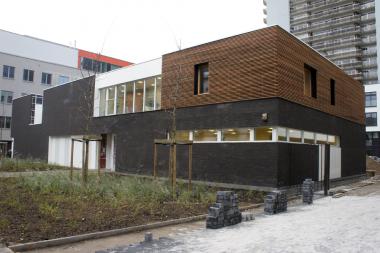
2013-02-18 - Just a stone’s throw from the towers of the WTC, right behind the Gare du Nord railway station, is an unusual block of buildings in the territory of Schaerbeek. As well as areas of greenery at the entrance and a small park to the rear, the Etoile du Nord nursery is remarkable for the materials from which it is made. It is not self-evident from its appearance, but the building is a passive construction: Schaerbeek’s first passive nursery. This innovative project, opened in December 2011, has already achieved very positive results.
It really is situated at a meeting of the ways, in the Gaucheret district between the yellow-brick structures by the railway, the old houses of Brussels and the skyscrapers of the Quartier Nord. Its large windows to the rear enable the daylight and sunshine to flood the building, and especially the rooms where the children are looked after. On the street side are the offices and entrance hall.
The director, Christine Robert, is thrilled. The innovativeness of the nursery has a positive impact on the mood of both staff and parents. “There are 48 full-time places here and ten more upstairs in the drop-in nursery. The children are divided into three sections: babies, intermediate and older. The project has benefited from support from the ERDF (European Regional Development Fund). The children mainly come from the local area, or in some cases their parents used to live in the district, have moved away, but are still working locally. Everyone feels very happy here.”
Responding to demographic growth
Brussels’ municipalities need to respond to substantial demographic growth, and in the city’s central districts over 50% of the inhabitants are under the age of 30. They therefore need to be able to provide more childcare places. In this connection, the Region has also launched a regional nursery plan in order to encourage the expansion of childcare provision. Above all, the objective is to respond to demand in the places where it arises.
The idea is also to regenerate buildings and districts, by renovating existing premises, creating new spaces, supporting passive constructions and offering both services and employment to the local population.
The Schaerbeek nursery very much reflects this plan. Three full-time equivalent jobs have been created in each of the three sections. The children’s food is also prepared on the spot. Other similar structures are under construction in the municipality. Elsewhere in Brussels, renovations are beginning to appear in some places: a former warehouse in Saint-Gilles, an industrial building in Laeken, an abandoned site in Molenbeek-Saint-Jean…
A warm and welcoming place
Light is ubiquitous at the Etoile du Nord, and heat is everywhere too – though not excessively. It comes from the floor, which is nice for the youngest children, who spend a lot of their time there. It also removes the need to install radiators, which are dust-traps and can also prove to be dangerous obstacles for the children.
The different sections are laid out to suit the age of the youngsters. For the tiny tots, up to the age of one, the space is barer, whereas in the two sections for the older children they are learning to use tables, whether for eating or for making things. To spare the nursery workers’ backs, an ingenious staircase enables the children to climb onto the changing table themselves, which they then leave using a slide: a solution that is simultaneously fun and functional.
The Etoile du Nord, which is recognised as an exemplary building in terms of energy and green building by Brussels Environment (IBGE-BIM, the Regional administration in charge of environment), is a truly state-of-the-art facility. Like the North Star after which it is named, it is showing the way. “The parents are increasingly looking for environmentally friendly features”, the director stresses. “All the food is prepared on the spot with organic products. The lighting in the corridors turns off automatically, as do the taps on the basins used by the children.”
A positive spiral
Thanks to its triple glazing and extensive insulation, the building does not need much heating. “It’s no worse, in fact it’s more pleasant,” adds Christine Robert. Overheated rooms are avoided, as are excessively chilly ones. It feels comfortable throughout. “That pleasant atmosphere also has an effect on the staff and even on the parents and the children.”
The investment required to construct such a building, made possible by the ERDF, is substantial: 2.2 million euros. The advantage of the passive design is that ultimately the costs for the community are lower. A high proportion of the staff and operating costs at nurseries (60%) is paid by the ONE (the Office for Childbirth and Children), while the rest of the bill is footed by the municipality and the parents.
Nap time is over. A little blonde girl who has just woken up holds out her arms to the director. She clings on for the rest of the visit. The drop-in centre is upstairs, in a kind of apartment. As in other nurseries in Brussels, these centres enable parents to drop their children off from time to time while they are attending training, a job interview or a medical appointment or for other reasons. The aim is to promote the social and job market integration of less advantaged groups.
A mother arrives to collect her child from the drop-in centre, which has more flexible hours in order to reflect the realities of work and training more closely. Outside, there is bitter winter weather; but that can be completely forgotten about inside the building.
Jean-Pierre BORLOO





















